How to Use German Volume Training to Crush Your Workouts

Back in the 1970s, the coach of the German national weightlifting team came up with a novel plan to bulk up some of his lifters. The routine was characterized by intense, rigid work and rest structures - and for its results.
By the 1990s, Canadian strength coach Charles Poliquin adopted the program, and has since popularized it as German Volume Training (GVT). If the name intimidates you, it should. There’s probably no more demanding or draining method of strength training out there.
But, if you have the intestinal fortitude to try it, the gains can be well worth the grueling effort. Achtung, baby.

For a full compendium of fitness knowledge, check out the Men's Health Encyclopedia of Muscle. The volume is chock full of workout routines, helpful training tips, and definitions for just about every gym-related term you've ever wanted to know.
How to Use German Volume Training
GVT is defined by its distinctive set-and-rep scheme: 10 sets of 10.
To make matters worse, your rest periods are short: 60 seconds between sets, if you’re doing one main lift (such as a squat or bench press), and 90 to 120 seconds between sets, if you’re alternating two lifts. “The intensity has to be cut down due to the volume of the sets and the lack of rest time,” says Don Saladino, a New York City trainer known for his work with superhero actors like Ryan Reynolds.

Start with a load that allows you 20 reps (this may equate to around 60 percent of your max), but perform only 10. The weight will feel too light for the first couple of sets, but, as you begin to fatigue, you’ll struggle, and you may not be able to get all 10 reps by the 5th or 6th set. That’s okay.
“Avoid going to failure on any set,” says Saladino, “and don’t decrease the weight.”
As your nervous system adapts, you may find that your reps increase again by the last few sets. Just keep aiming for 10 reps, and make note of how many reps you get each set. When you can do all 10 sets for 10 reps, increase the weight by 5 percent the next time you do the workout.
Tempo Torture
To add to the torture, you’ll need to perform the exercises with a specific tempo. Lifts that have a big range of motion (squats, deadlifts, chinups) should be done with a 4-0-2-0 tempo (4 seconds downward for the eccentric portion, 0 second pause at the bottom, 2 seconds up for the concentric portion, 0 seconds at the top); shorter-range moves (leg curls, cable rows) can be done with a 3-0-2-0.

Do only one exercise per body part with the 10 x 10 system, and only up to two exercises with this method in a single workout. You can do two to three other accessory exercises that train different muscle groups, or one more for the same muscles you worked with 10 x 10 for three sets of 10 to 12 reps each. After four exercises total, your workout is over.
For GVT to work, you have to be able to recover from each session, so train each body part only once every 4 to 5 days. Try the following split to work your :
Monday: Chest and Back
Tuesday: Legs and Abs
Wednesday: Rest
Thursday: Arms and Shoulders
Friday: Rest
Saturday: Start Over
The German Volume Training Trial Workout
The workouts correspond to the training split outlined above. You’ll perform three different training days for five total workouts in a week. Alternate sets of the paired exercises (marked A and B). So, you’ll do one set of A, rest, then one set of B, rest again, and repeat until all sets are complete for the pair. Perform the remaining exercises as straight sets, completing one set after another, in turn.
For the 10 sets of 10 exercises, choose a load that you can do 20 reps with, and stick with it for all 10 sets, even if you can’t make all 10 reps with good form. Do not take any sets to failure - quit when you have one rep left in you. Over time, work to get all 10 reps for each set, and then increase the load by 5 percent. Try the program for 4 weeks.
Day 1
1A Dumbbell Bench Press
Sets: 10
Reps: 10
Tempo: 4020
Rest for 90 seconds
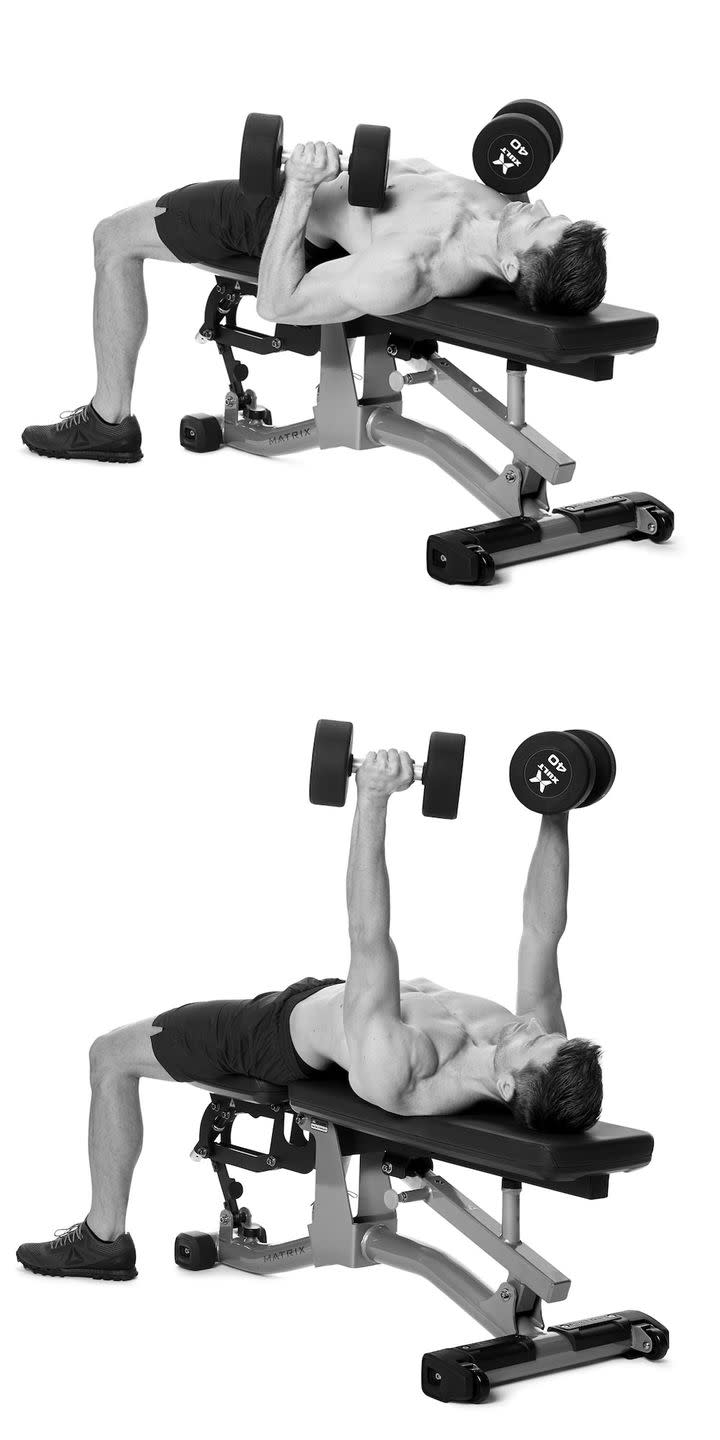
Lie back against a flat bench with a dumbbell in each hand at shoulder level. Press the dumbbells over your chest, and then lower them back to your chest.
1B Lat Pulldown
Sets: 10
Reps: 10
Tempo: 4020
Rest for 90 seconds
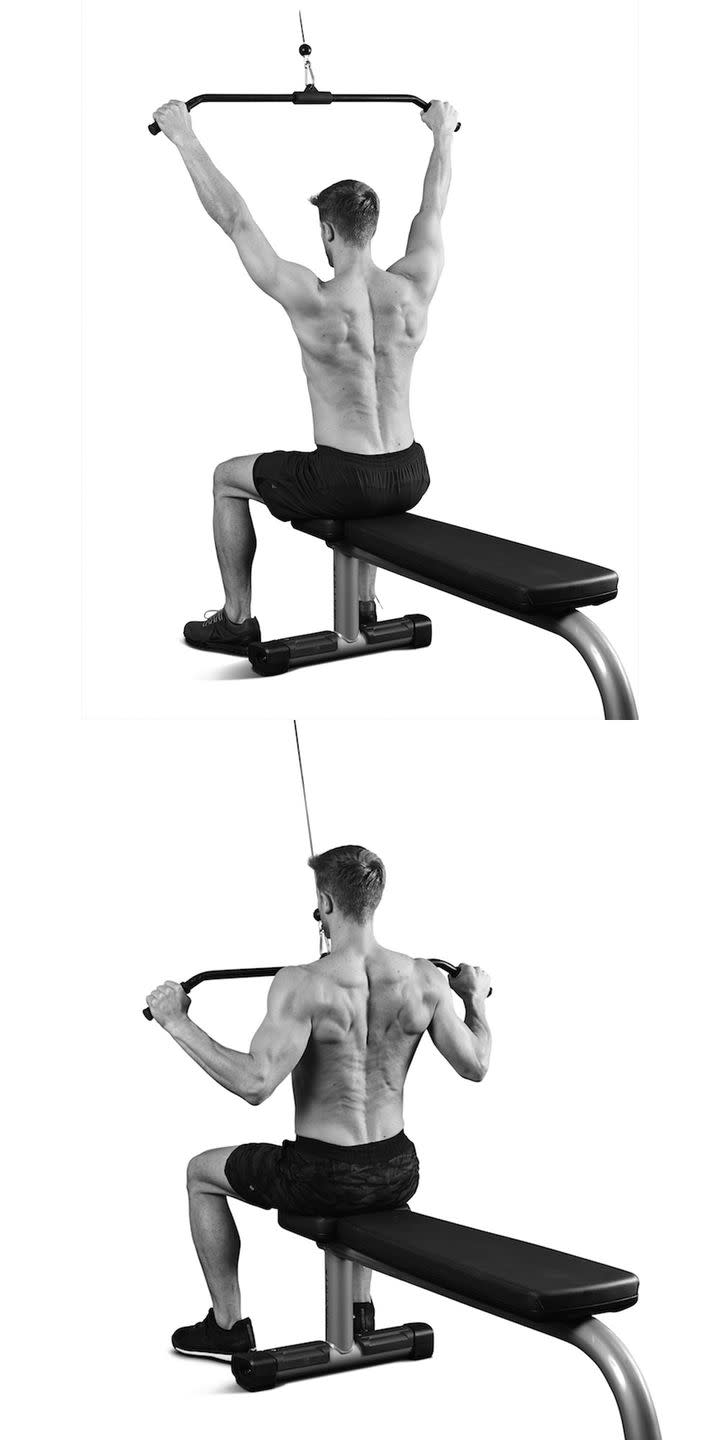
Sit at a pulldown station, and secure your knees under the pads. Grasp the bar with your hands at shoulder width and your palms facing away from you. Pull the bar to your collarbone, and control its path back up
2A Incline Dumbbell Fly
Sets: 3
Reps: 10 to 12
Tempo: 3020
Rest for 60 seconds
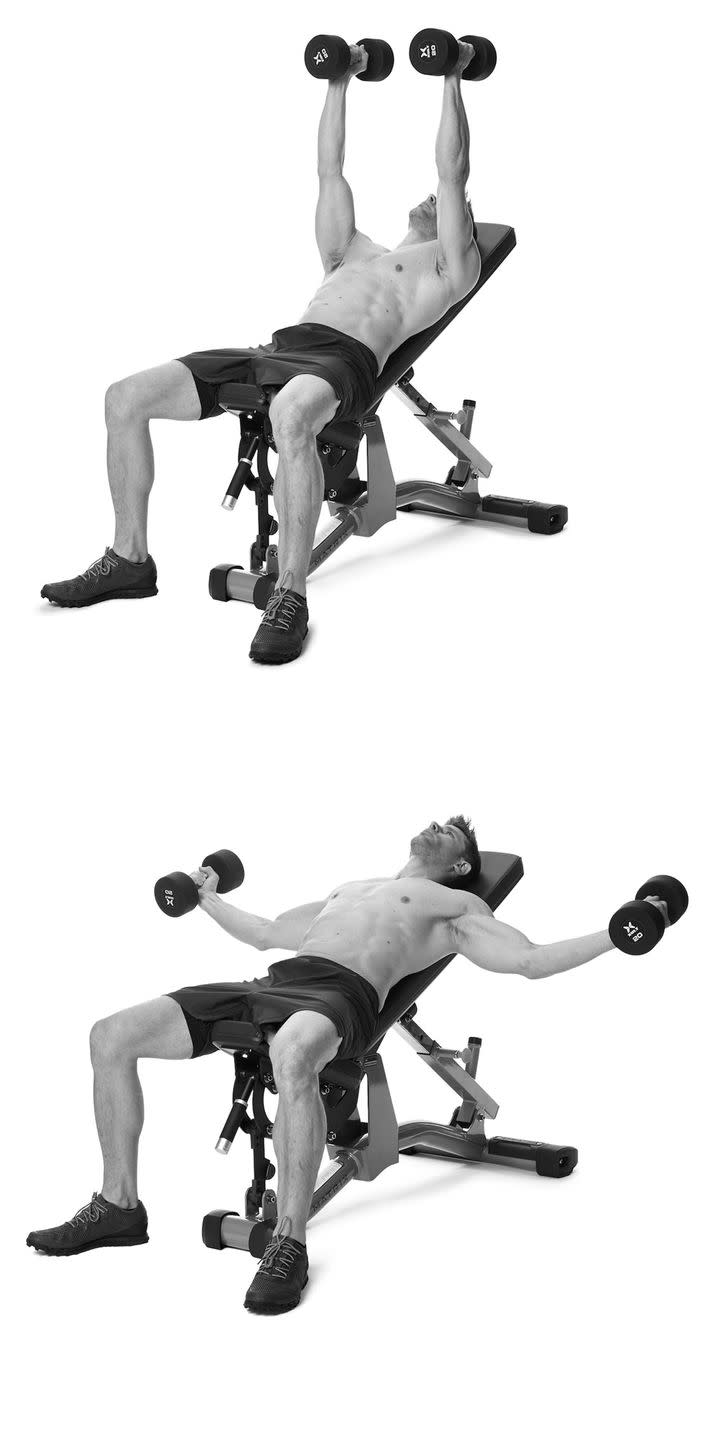
Set an adjustable bench to a 45-degree incline, and lie back against it with a dumbbell in each hand. Press the dumbbells from shoulder level to overhead and turn your palms in to face each other. Bend your elbows slightly and slowly spread your arms apart, lowering the weights out to your sides until you feel a stretch in your chest. Bring the dumbbells back over your chest, as if you were giving someone a bear hug. That’s one rep
2B Face Pull
Sets: 3
Reps: 10 to 12
Tempo: 3020
Rest for 60 seconds
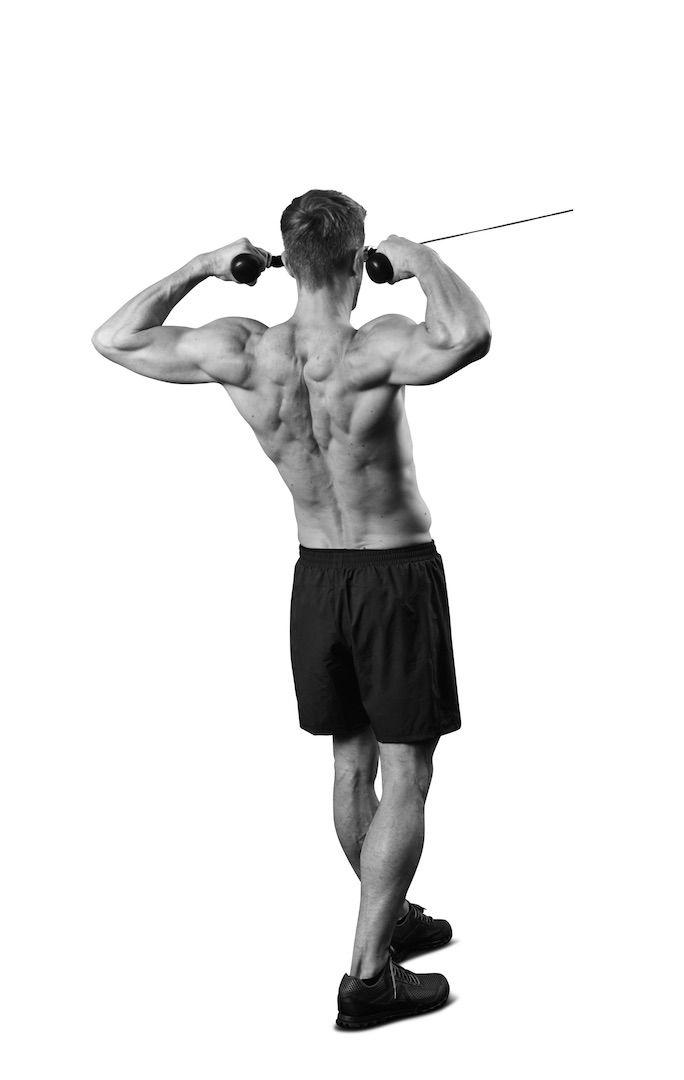
Attach a rope handle to the top pulley of a cable station. Grasp an end in each hand with your palms facing each other. Step back to place tension on the cable. Draw your shoulder blades together and down as you pull the handle to your forehead, so your palms face your ears and your upper back is fully contracted.
Day 2
1 Squat
Sets: 10
Reps: 10
Tempo: 4020
Rest for 60 seconds
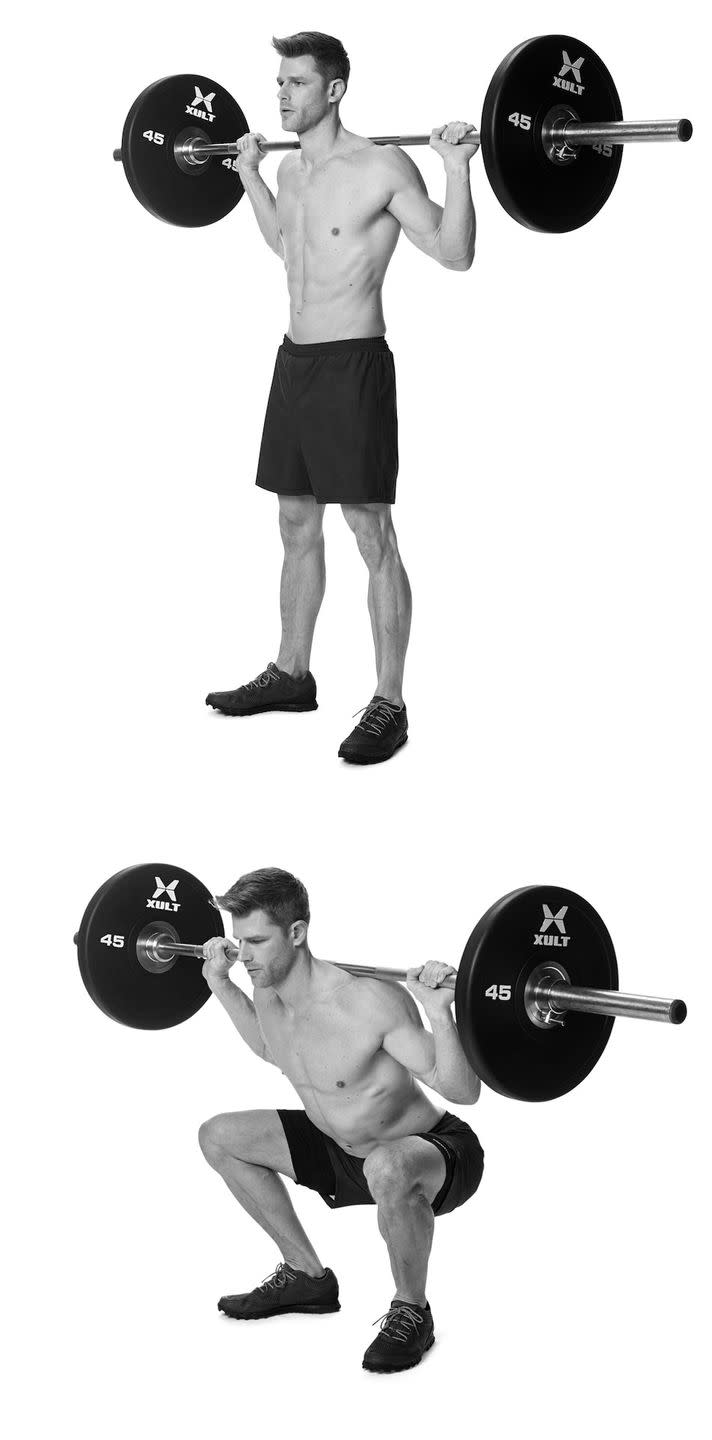
Set up in a squat rack and grasp the bar with your hands as far apart as is comfortable. Step under the rack and squeeze your shoulder blades together and down, wedging yourself under the bar so that it rests on your traps or the back of your shoulders. Nudge the bar out of the rack and step back, setting your feet at shoulder width with your toes turned slightly outward. Without letting your feet actually move, try to screw both legs into the floor as if you were standing on grass and wanted to twist it up- you’ll feel your glutes tighten and the arches in your feet rise. Take a deep breath into your belly and bend your hips back, then bend your knees and lower your body down. Push your knees out as you descend. Go as low as you can while keeping your head, spine, and pelvis aligned, and then extend your hips and knees to return to standing.
2 Leg Curl
Sets: 3
Reps: 10 to 12
Tempo: 3020
Rest for 60 seconds
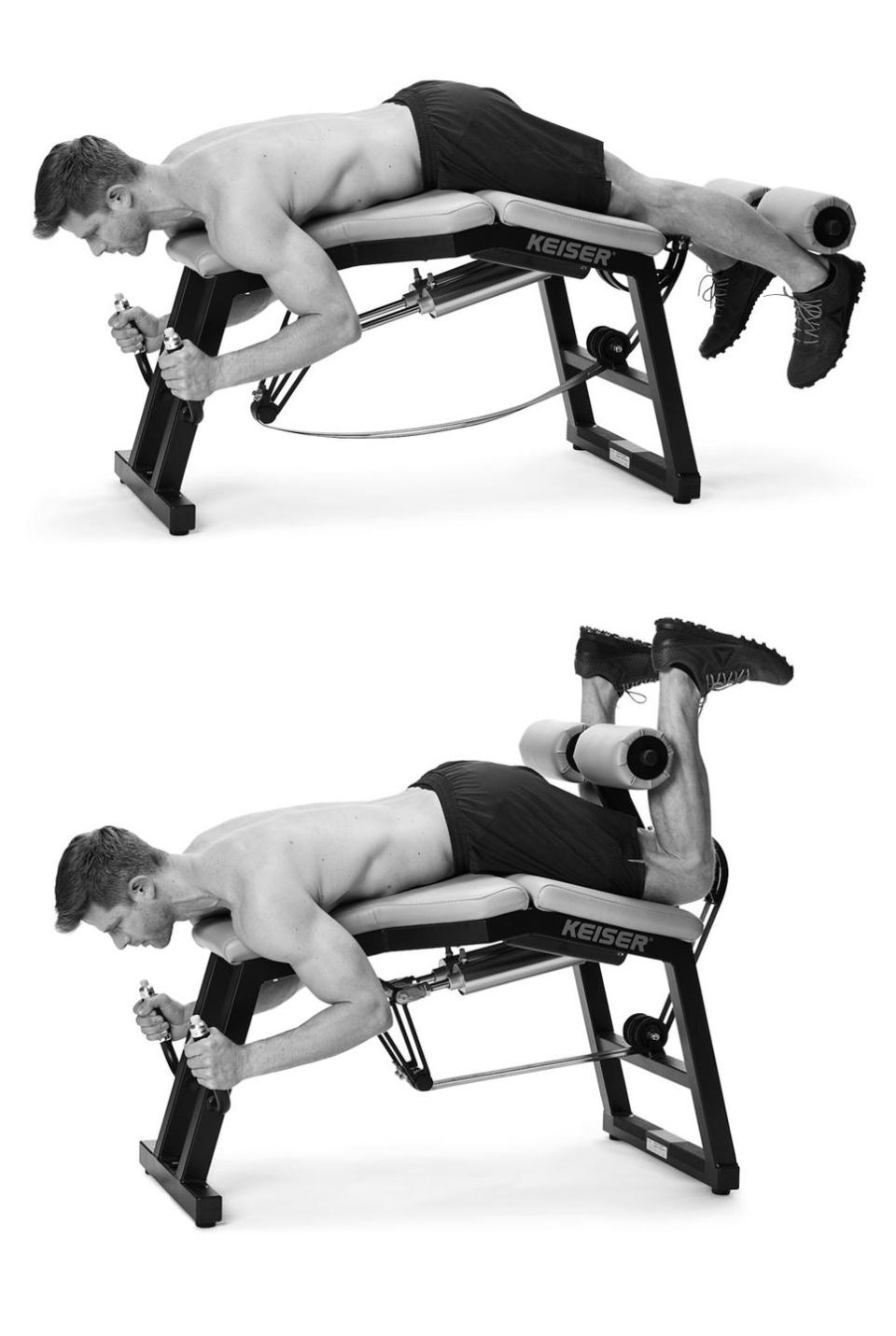
Lie on a leg curl machine, align your knees with the machine’s axis of rotation, and secure your ankles under the pad. Curl the weight until your hamstrings are fully contracted and then extend your legs
3 Standing Calf Raise
Sets: 3
Reps: 10 to 12
Tempo: 3020
Rest for 60 seconds
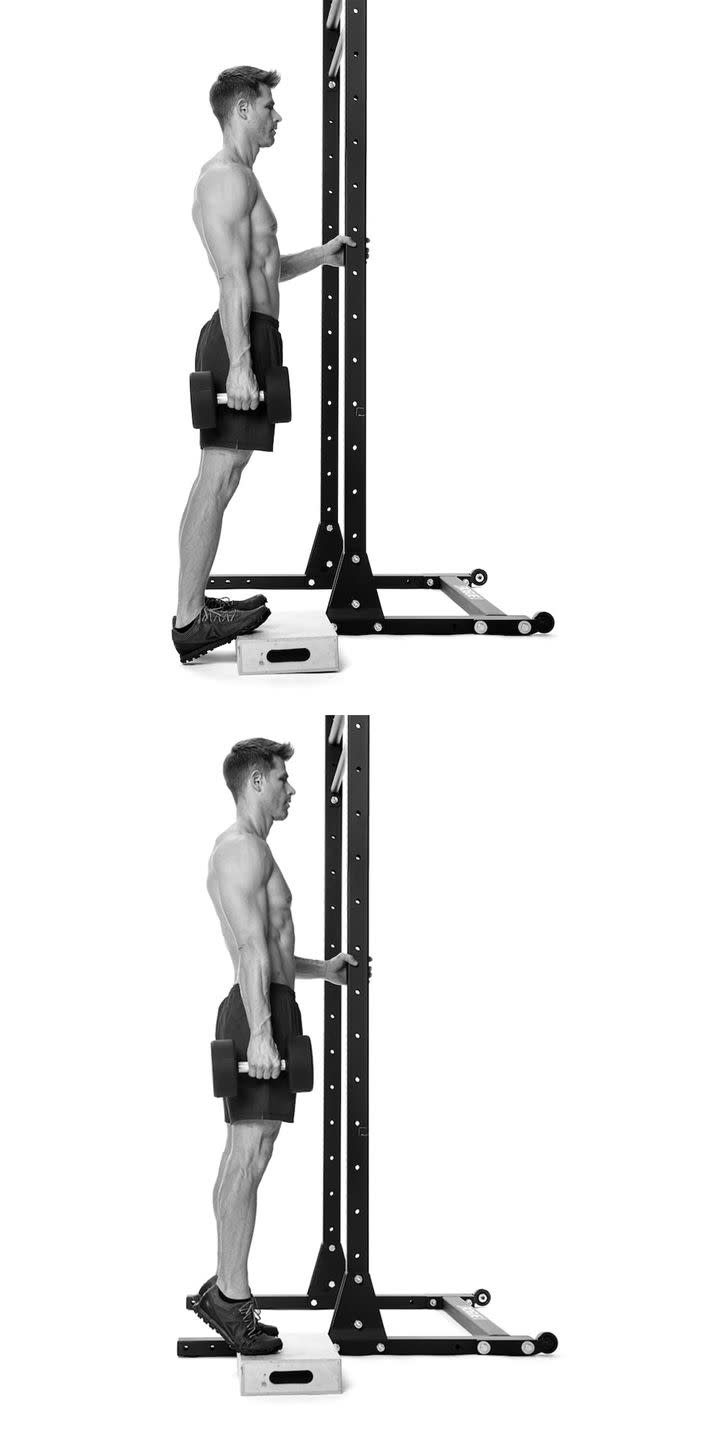
Use a standing calf raise machine, or stand on a block or step with a dumbbell in one hand, while holding onto something for support with the other. Lower your heels toward the floor until you feel a stretch in your calves. Drive the balls of your feet into the foot plate or step, and contract your calves, raising your heels as high as possible. Control the descent on each rep.
4 Plank
Sets: 3
Reps: Hold for 60 seconds
Rest for 60 seconds
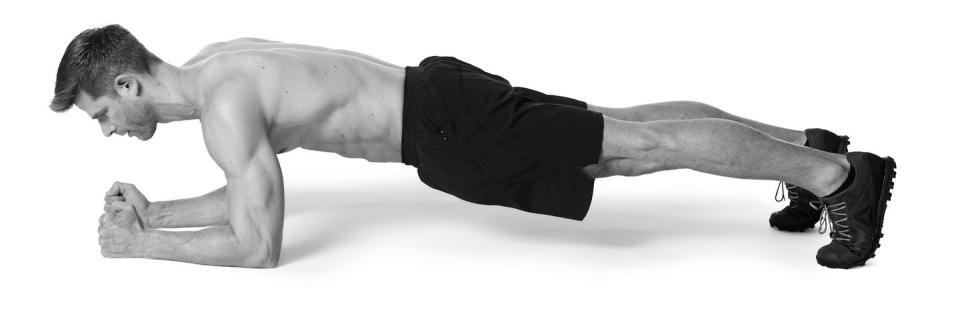
Get into a pushup position, and then bend your elbows to lower your forearms to the floor. Hold your body in a straight line with your ribs pulled down and your tailbone tucked under. Note that there is no tempo for planks.
Day 3
1A Close Grip Bench Press
Sets: 10
Reps: 10
Tempo: 3020
Rest for 60 seconds
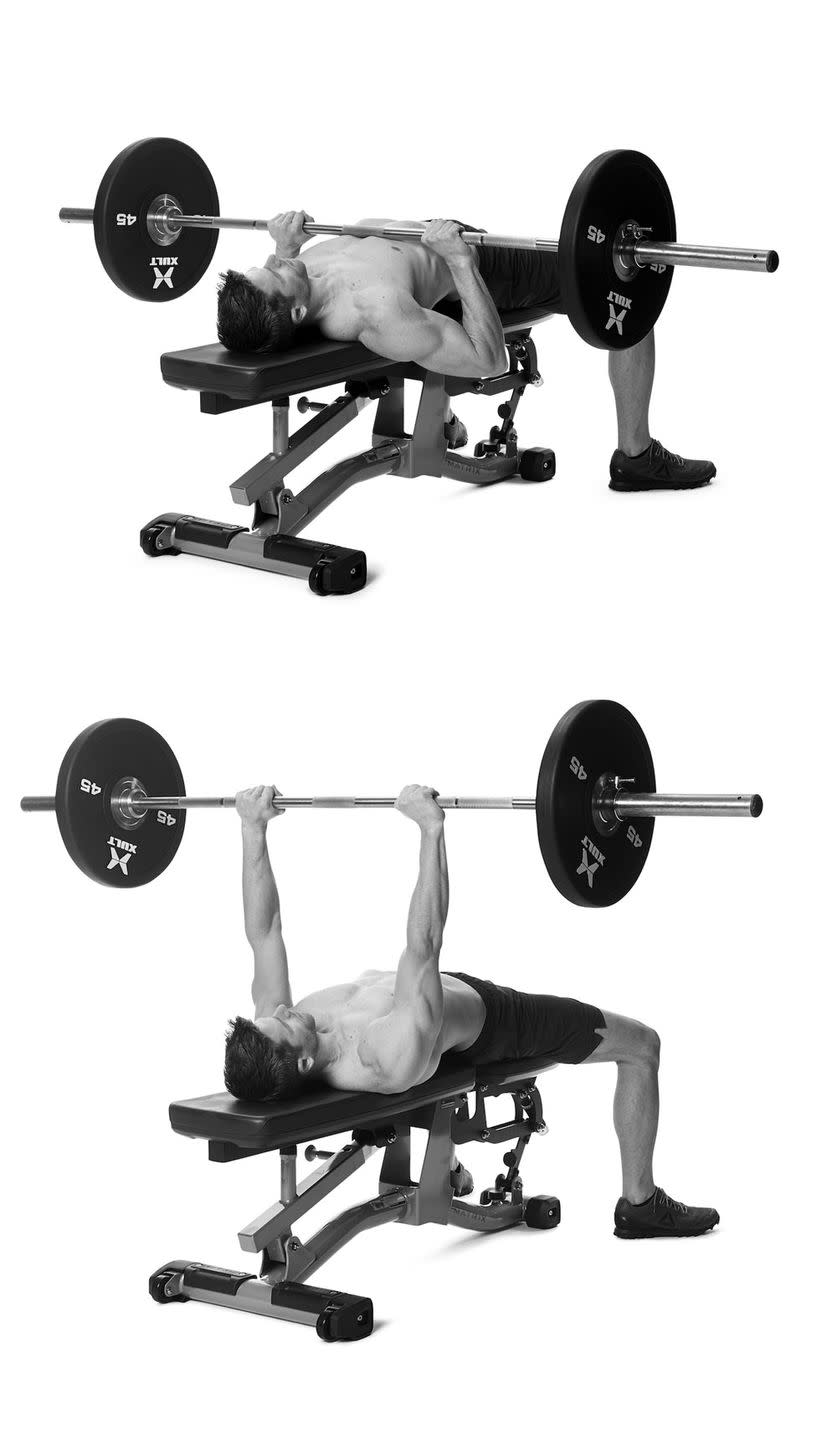
Arch your back, pulling your shoulder blades down and together. Grasp the bar with hands at shoulder width and pull it out of the rack. Take a deep breath, tighten your glutes, and lower the bar to your sternum, tucking your elbows 45 degrees to your sides on the descent. When the bar touches your body, push your feet into the floor and press the bar up at the same time
1B Barbell Curl
Sets: 10
Reps: 10
Tempo: 3020
Rest for 60 seconds
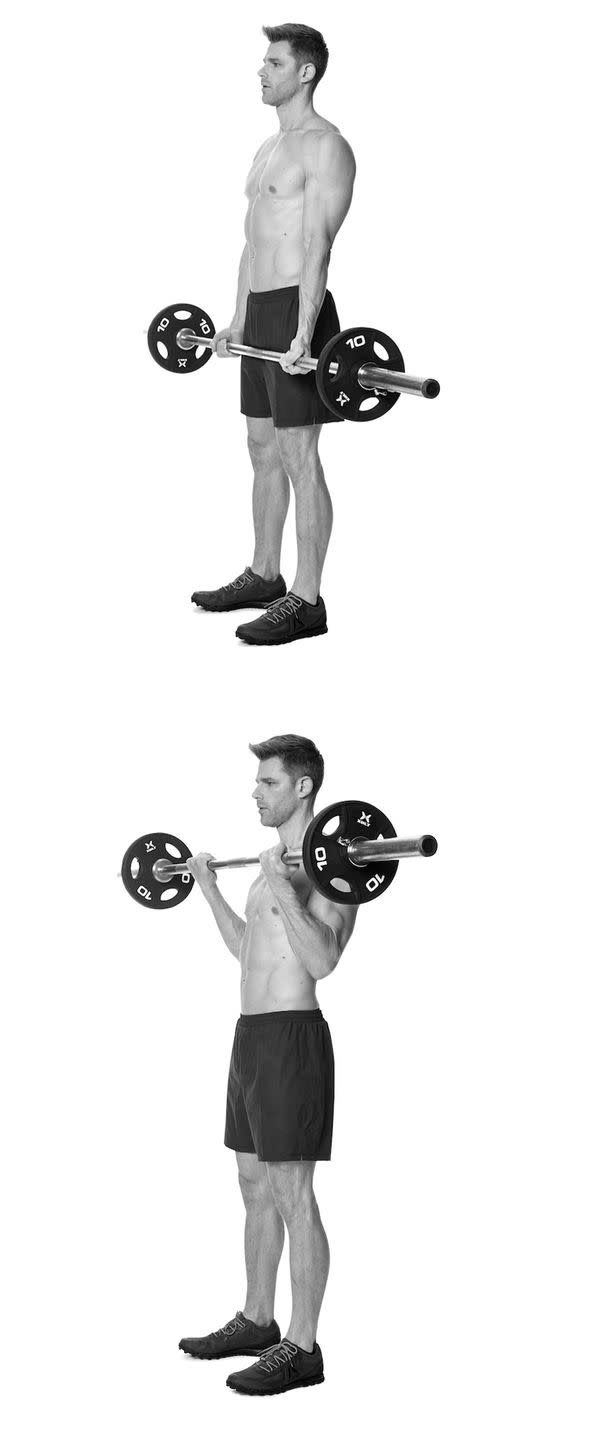
Hold a barbell in front of your thighs with your hands shoulder width apart. Stand with your feet at shoulder width and your knees slightly bent. Keeping your upper arms in place, curl the bar until your biceps are fully contracted, and then lower back down
2 Lateral Raise
Sets: 3
Reps: 10 to 12
Tempo: 3020
Rest for 60 seconds
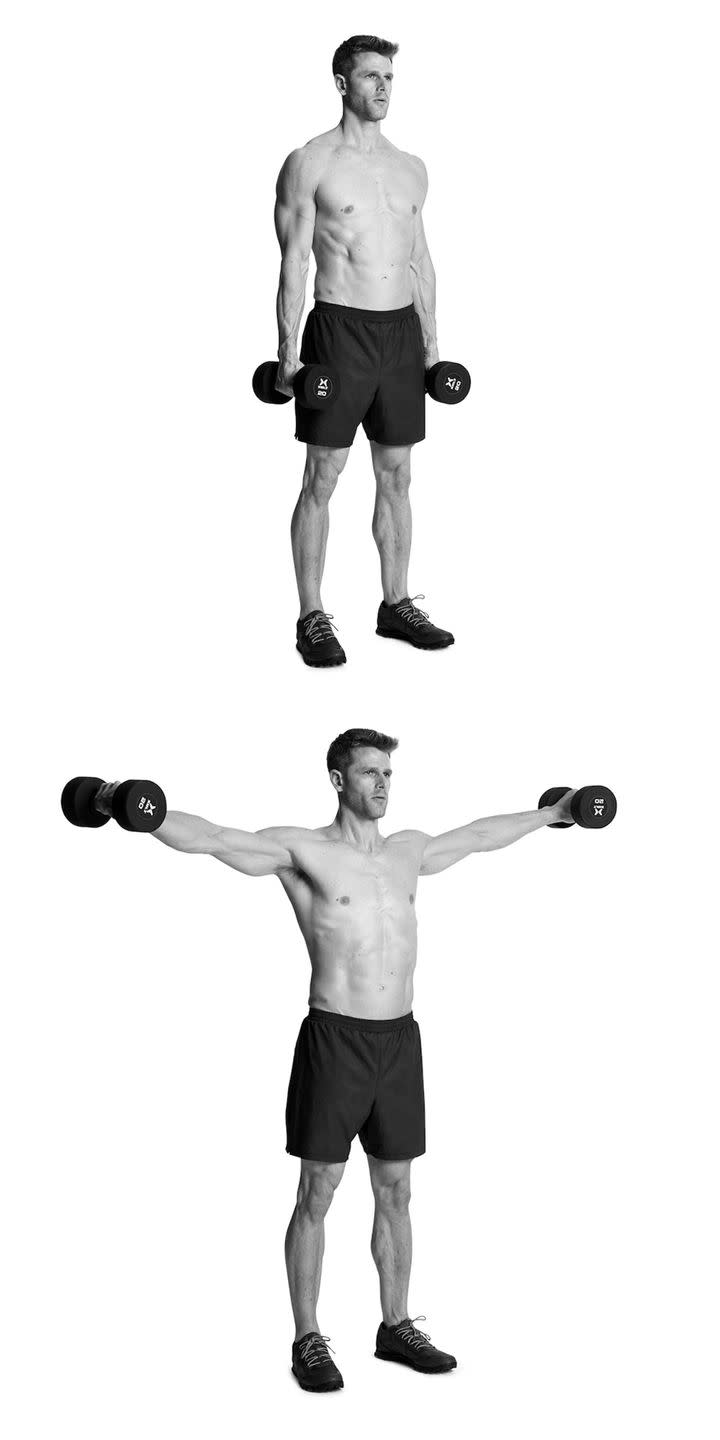
Stand with feet shoulder-width apart, holding a dumbbell in each hand. Raise your arms out 90 degrees to your sides with elbows straight, and then lower back down.
3 Chest Supported Reverse Fly
Sets: 3
Reps: 10 to 12
Tempo: 3020
Rest for 60 seconds
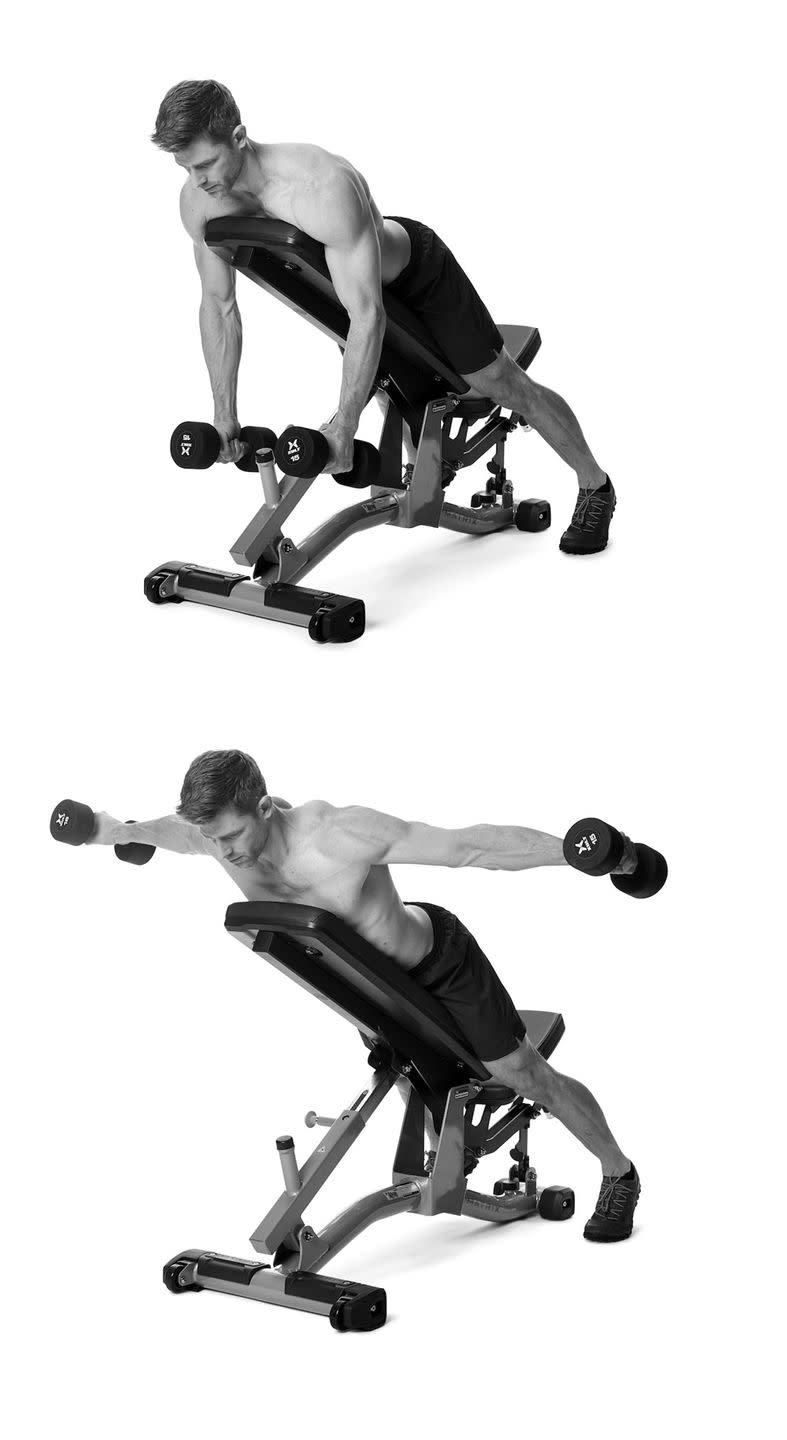
Set an adjustable bench to a 45-degree angle, and lie on it chest-down. Grasp a dumbbell in each hand and, keeping your arms straight, raise your arms out to your sides at 90 degrees. Pull your shoulder blades together and downward as you lift, and then lower the weights back down.
('You Might Also Like',)

